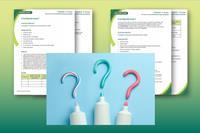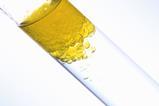Nine out of ten dentists recommend using this resource to teach neutralisation
Toothpastes provide everyday examples of neutralisation reactions, to help you put this topic into context. Use the downloadable equipment list, method and questions, or ask your learners to design their own practical to determine the basicity of different toothpastes – see guidance for setting up a problem-solving practical. A results table and answers to the questions are also available in the teacher notes.
This resource accompanies the Education in Chemistry article Everyday neutralisation myths busted.
Learning objectives:
- Develop observation skills by comparing the pHs of different toothpastes.
- Determine which properties are best for neutralising mouth acid and why.
Equipment:
- 3 test tubes
- Distilled water
- 3 brands of toothpaste (we used Aquafresh 24h sugar acid protection, Colgate cavity protection and Arm and hammer charcoal white*)
- 3 eye droppers / Pasteur pipettes
- 1 spotting tile
- Universal indicator
- 0.1 M ethanoic acid (danger: corrosive and flammable)
- Safety spectacles
* Other toothpaste brands are, of course, available to be tested. Those used here provided a good selection of properties (neutral, alkaline and basic). Neutral toothpastes will contain no bases or alkalis in the ingredients. Calcium carbonate will often be the insoluble base included as an ingredient, acting as an abrasive too. Bicarbonate of soda (sodium bicarbonate) is the alkaline ingredient to look out for.
Method:
- Take three test tubes and add approximately 1 cm of water to each.
- Add a pea-sized amount of one of the toothpastes to a test tube and mix. Repeat for the other toothpastes in separate test tubes.
- Add a drop of one toothpaste solution to a well in the spotting tile and add a drop of universal indicator to the same well. Note the colour change in your results table. Repeat for the other toothpaste solutions in empty wells.
- Add a drop of 0.1 M ethanoic acid to three empty wells and note the colour when a drop of universal indicator is added to each.
- Add a drop of the first toothpaste solution to a well with acid. Note any colour change. Repeat for the other two toothpaste solutions.
- Complete the table with your results and answer the questions, making your conclusions.
Questions:
- What pH is the 0.1 M ethanoic acid?
- Why are we using ethanoic acid and neutralising it using toothpaste?
- What other ‘food acids’ (weak acids) could you use?
- Why would you want your toothpaste to neutralise mouth acid?
- Which toothpaste(s) can neutralise mouth acid?
- Which toothpaste(s) could result in an alkaline mouth cavity?
- Explain which toothpaste you think would be best for mouth cavity acid neutralisation?
- How else could you address mouth cavity pH changes?
- Do you think basic (acid neutralising) toothpastes are better than neutral toothpastes?
More resources
- Carry out this experiment Using indigestion tablets to neutralise an acid, with teacher notes and student questions to download.
- Use these activities to explore the chemical concepts involved in hair care, shampoos and conditioners.
- Share this job profile of a consumer products technician who uses polymers to solve problems in everyday products.
- Find more problem-solving activities to engage, motivate and develop the key skills of your 11–14 and 14–16 learners.
Downloads
Is toothpaste basic student sheet
Editable handout | Word, Size 0.43 mbIs toothpaste basic student sheet
Handout | PDF, Size 0.13 mbIs toothpaste basic teacher notes
Editable handout | Word, Size 0.43 mbIs toothpaste basic teacher notes
Handout | PDF, Size 0.13 mb
























1 Reader's comment